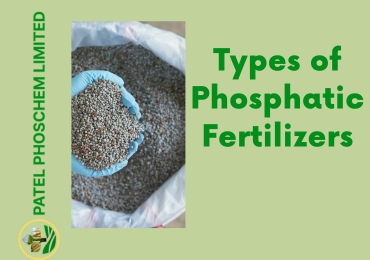
Types Of Phosphatic Fertilizers And Their Applications
Phosphorus is an essential nutrient for plant growth and development, playing a crucial role in energy transfer and metabolism. However, many soils lack an adequate supply of phosphorus, which can limit crop productivity. To address this issue, phosphatic fertilizers are widely used to supplement phosphorus in agricultural practices. In this blog, we Patel Phoschem delve into the various types of phosphatic fertilizers available and explore their applications in modern agriculture.
Superphosphate Fertilizers:
- Superphosphate fertilizers are derived from naturally occurring phosphate rock and are processed to make them more readily available to plants. They are usually available in two forms: single superphosphate (SSP) and triple superphosphate (TSP). SSP contains 14-20% phosphorus, while TSP has a higher phosphorus content ranging from 44-52%. These fertilizers are commonly used to provide an immediate source of phosphorus to plants and are suitable for most soil types.
Diammonium Phosphate (DAP):
- Diammonium phosphate, commonly known as DAP, is a granular fertilizer that contains a high concentration of both nitrogen and phosphorus. With a phosphorus content of around 18-46%, DAP is popular due to its versatility and ability to enhance root development, flowering, and fruiting in various crops. It is particularly useful in early growth stages and can be applied to both acidic and alkaline soils.
Monoammonium Phosphate (MAP):
- Similar to DAP, monoammonium phosphate (MAP) is a granular fertilizer that contains both nitrogen and phosphorus. It typically contains 10-22% phosphorus and is known for its high water solubility, making it readily available to plants. MAP is favored for its ability to promote root growth and is commonly used for crops requiring additional phosphorus during the early stages of growth.
Phosphoric Acid:
- Phosphoric acid is a concentrated liquid fertilizer with a phosphorus content ranging from 45-52%. It is derived from phosphate rock through a chemical process and is highly soluble in water. Phosphoric acid is often used as a foliar spray or in fertigation systems to provide an immediate and efficient supply of phosphorus to plants. It is particularly beneficial for crops with high phosphorus requirements, such as fruits, vegetables, and oilseeds.
Bone Meal:
- Bone meal is an organic phosphatic fertilizer made from crushed animal bones. It is a slow-release fertilizer, meaning it gradually releases phosphorus over an extended period. Bone meal typically contains 3-6% phosphorus and is an excellent choice for organic farming practices. It not only provides phosphorus but also contributes to the overall improvement of soil structure and microbial activity.
FAQS
Phosphatic fertilizers
- Phosphatic fertilizers are important nutrients for plants because they contain phosphorus, which helps with root development, energy transfer, and flowering. However, many soils don’t have enough phosphorus, which can limit crop growth. That’s why phosphatic fertilizers are widely used in agriculture to add phosphorus to the soil and improve crop productivity. There are different types of phosphatic fertilizers available, made from various sources, and they provide plants with the essential phosphorus they need to grow. In this blog, we will explore the different types of phosphatic fertilizers and how they are used in modern farming. It’s like going on a journey through the world of phosphatic fertilizers, discovering the many options that can help enhance agriculture. So come with us and learn more about these fertilizers and their applications in farming. We’ll explore the different types and their benefits, all aimed at nourishing the soil and improving crop growth.
Various types of phosphatic fertilizers exist, including:
- Manufacturers produce triple superphosphate (TSP) by treating phosphate rock with phosphoric acid, resulting in a fertilizer with a higher phosphorus content than SSP.
- Diammonium phosphate (DAP) is a granular fertilizer that contains both ammonium nitrogen and phosphorus. It provides the advantage of simultaneously supplying both essential nutrients.
- Monoammonium phosphate (MAP) is another granular fertilizer that resembles DAP. It contains both ammonium nitrogen and phosphorus, albeit in different proportions.
Phosphatic fertilizers find various applications, including:
- Agricultural use: Farmers utilize them to improve soil fertility and boost crop yields by supplying plants with the necessary phosphorus for growth and development.
- Horticultural use: Gardens, nurseries, and greenhouses employ phosphatic fertilizers to stimulate healthy plant growth, particularly in phosphorus-deficient soils.
- Turf management: Groundskeepers use them to preserve and improve the health and strength of lawns, sports fields, and golf courses. Phosphatic fertilizers provide phosphorus for root development and overall plant health.
Future of phosphatic fertilizers
- Sustainable and efficient practices hold the key to the future of phosphatic fertilizers. Stakeholders are increasingly emphasizing the optimization of fertilizer application rates and the reduction of nutrient losses through techniques such as precision agriculture and controlled-release fertilizers. Furthermore, researchers are actively developing methods for phosphorus recycling from organic waste and exploring alternative types phosphorus sources. These efforts aim to decrease dependence on finite phosphate rock reserves and promote a more sustainable phosphatic fertilizer industry.
Phosphatic fertilizers play a vital role in modern agriculture by ensuring an adequate supply of phosphorus to plants. Whether it’s superphosphate fertilizers, DAP, MAP, phosphoric acid, or bone meal, each type offers distinct advantages and applications in different agricultural contexts. Understanding the characteristics and benefits of these phosphatic fertilizers manufacturer empowers farmers and gardeners to make informed decisions when it comes to enhancing crop productivity and maintaining soil fertility.


Very good write-up. I definitely love this site. Continue the good work!